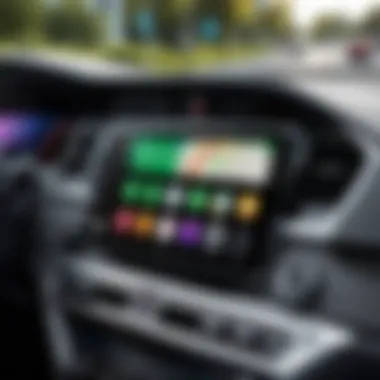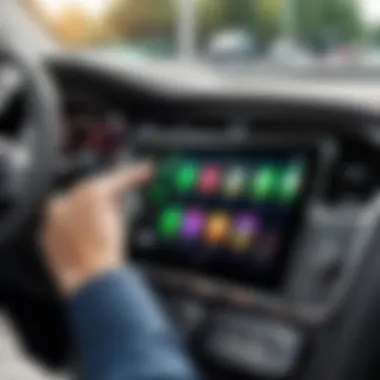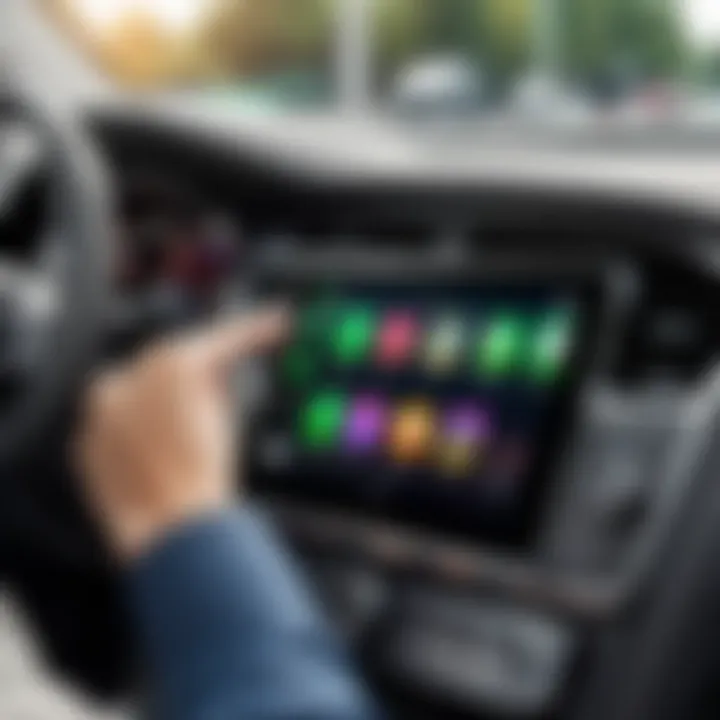Wireless CarPlay: Transforming In-Car Connectivity


Intro
In recent years, Wireless CarPlay has made significant strides in transforming the way drivers interact with their vehicles. Gone are the days when cumbersome wires dictated how we accessed navigation, music, and messages while on the road. This innovative technology not only simplifies connectivity but also enhances safety by minimizing distractions. With car manufacturers gradually adopting this feature, it's imperative to dive into its operational essence, its standout attributes, and how it aligns with the fast-evolving automotive landscape.
Product Overview
Wireless CarPlay is more than just a fad; it represents a paradigm shift in automotive technology. By allowing seamless integration between iOS devices and in-car infotainment systems, it brings the digital world closer to our driving experience. Let's break down the key features and technical specifications to see what makes this technology a game-changer.
Key Features
- Seamless Connectivity: One of the standout attributes of Wireless CarPlay is its ability to automatically connect to a compatible vehicle as soon as the driver enters, eliminating the need for cables.
- User-Friendly Interface: The interface retains the familiar iOS design, allowing even the most technologically challenged individuals to navigate with ease.
- Voice Control Capabilities: With Siri at the helm, drivers can manage calls, messages, and music all through voice commands, which minimizes the need to take eyes off the road.
- Enhanced App Compatibility: In addition to core features like navigation and music, Wireless CarPlay supports numerous third-party applications, allowing for a personalized user experience.
Technical Specifications
- Bluetooth and Wi-Fi Direct Technologies: Wireless CarPlay leverages both protocols to ensure swift data transfer and stable connections.
- Device Compatibility: While primarily designed for iPhones, the effectiveness of Wireless CarPlay is evident in its compatibility with various vehicle models, dating back to 2016 and beyond.
- Processor Requirements: Optimal performance necessitates an advanced in-car system, typically requiring a processing unit that can handle high-bandwidth tasks effortlessly.
The integration of these features offers a peek into a future where drivers can remain connected with minimal disruption, enhancing both the practicality and enjoyment of driving.
Performance Analysis
As with any technology, assessing the real-world efficacy of Wireless CarPlay is vital. It’s not just about what it boasts on paper; rather, it’s about how these capabilities translate on the road.
Benchmark Test Results
In comprehensive tests assessing latency and connectivity strength, Wireless CarPlay consistently demonstrates impressive performance. For instance, latency during app launch and interaction typically remains under one second, creating a fluid experience for the user. Many independent assessments have highlighted the optimal functioning of Wireless CarPlay in urban environments with multiple device connections, showcasing how it holds up against traditional wired systems.
Real-World Usage Scenarios
Consider John, a daily commuter. He recently upgraded his car to include Wireless CarPlay. Initially, he was skeptical—would he really notice a difference? On his first drive, he discovered the joy of accessing Google Maps without fumbling for cords. Even during moments of heavy traffic, he effortlessly toggled playlists and sent messages using only voice commands, turning his daily commute into a more manageable and enjoyable task.
"I never thought staying connected while driving could be this convenient. It’s like having a personal assistant in my car," John states enthusiastically.
This highlights how Wireless CarPlay not only enhances everyday functionality but also contributes to safer driving practices by reducing the tendency to fumble around with devices while en route.
The functionality, ease of use, and significant safety benefits underline the transformative potential of Wireless CarPlay in modern vehicles. The way we interact with technology in our cars is evolving, and it seems there's no turning back.
Prelims to Wireless CarPlay
As cars become increasingly sophisticated, the integration of smart technology into vehicles has shifted from a luxury to a necessity. This section, Introduction to Wireless CarPlay, sets the stage for understanding how this innovation is reshaping the driving experience. Wireless CarPlay allows drivers to shortcut the mess of cables and enjoy better connectivity, putting the power of their smartphones right at their fingertips.
Definition and Purpose
At its core, Wireless CarPlay is an Apple feature that enables drivers to connect their iPhones to their car's infotainment system without any physical connections. This seamless integration not only allows access to music, navigation, and messaging but also enhances safety by minimizing distractions.
Think of it like having a friendly co-pilot—your music follows you, your maps are always at hand, and you can dictate messages while keeping your eyes on the road. The primary purpose is twofold: to promote ease of use and to increase safety while driving. With a few taps or voice commands, users can access vital information and entertainment, transforming the user experience inside the car.
Historical Context
The journey of CarPlay started with the rising demand for smarter and more intuitive car interfaces. Initially launched in 2014, it relied heavily on wired connections. Drivers were tethered to their devices, creating a clutter that wasn’t conducive to a smooth driving experience. However, technological advancements soon led to the development of wireless capabilities.
Around 2016, as the push for cord-free living gained momentum, Apple began expanding CarPlay’s functionality. This paved the path for manufacturers to integrate wireless systems, allowing drivers to dock their phones without needing to connect a cable.
Today, Wireless CarPlay stands as a vital cog in the evolving narrative of automotive technology, addressing the gaps left by earlier models. The evolution from wired simplicity to wireless convenience underscores not just a change in technology, but a profound shift in consumer expectations and lifestyle choices.
Understanding this historical context helps underscore the importance and evolution of the technology, as well as the opportunities and challenges it presents to both consumers and manufacturers.
Technical Architecture of Wireless CarPlay
The technical architecture behind Wireless CarPlay plays a vital role in shaping the in-car infotainment experience. It allows for seamless integration of smartphones with vehicles, enabling users to access their devices without the mess of cables. The architecture lies at the intersection of several technologies, primarily focused on wireless connectivity and efficient data transfer. Understanding these components helps to appreciate the advancements and offers insights into future developments in automotive tech.
Underlying Technologies
Wi-Fi Direct
Wi-Fi Direct is a game changer in how devices communicate without the rough edges of traditional networking setups. This technology enables direct connections between devices, eliminating the need for a central router. What's notably beneficial here is the ability to stream higher bandwidth content with reduced latency—crucial for a smooth user experience when using apps and services like Spotify or Maps on the go.
A key characteristic of Wi-Fi Direct is its flexibility. Users can connect multiple devices in one go without fussing over network settings, making it super convenient for families or friends carpooling to their destination. But there are some drawbacks worth mentioning. For instance, if a vehicle's environment is cluttered with multiple electronic devices, the connection might struggle, leading to potential drops.
Bluetooth Specifications
Bluetooth specifications are another cornerstone of Wireless CarPlay's architecture. This technology is well-known for its low energy consumption, making it ideal for mobile applications where battery life is a concern. Typically, it's the first handshake in establishing a connection before switching to suited technologies like Wi-Fi Direct for heavier media tasks.
One of the standout features of Bluetooth is its compatibility across a vast array of devices. It's practically a universal language that most smartphones and car infotainment systems can speak. However, its bandwidth limitations can be a disadvantage, especially when it comes to streaming high-quality video. Depending on the implementation, users might experience lower resolutions or buffering during heavy usage.
Data Transmission Protocols
Audio and Video Streaming
Audio and video streaming protocols form the foundation of how content is delivered in a Wireless CarPlay environment. These protocols define how data packets are transmitted, ensuring they arrive intact and in order. Their importance cannot be understated when it comes to delivering an enjoyable user experience, especially for those who rely on entertainment during their drives.


A major benefit of these streaming protocols is dependable quality, even while on the move. They enable users to enjoy clear audio without stuttering or interruptions. However, the reliance on constant connectivity introduces challenges. When signal strength fluctuates—say, in areas with poor reception—audio or video performance can degrade significantly.
Control Protocols
Control protocols are often the unsung heroes in a wireless setup. They manage how users interact with their devices—think voice commands, touch controls, and gesture recognition. This allows users to keep their focus on the road, acting swiftly on their requests with minimal delay. This aspect of control is becoming increasingly vital as safety regulations dictate how drivers should engage with technology.
One distinctive feature of these protocols is their layered approach. They prioritize tasks to ensure critical commands find their way through first, leading to efficient communication. Yet, complications can arise; a poorly designed system could result in conflicting responses or delays—factors that could inadvertently distract a driver.
"Seamless integration of car technology with everyday devices is no longer a luxury; it's an expectation."
Compatibility and Requirements
When discussing Wireless CarPlay, understanding compatibility and requirements is like knowing the rules of the road before you hit the gas. This section emphasizes how crucial it is for users to grasp the various devices and systems that facilitate this technology. With the push for seamless connectivity in modern vehicles, having knowledge on what devices work best and what system prerequisites need addressing becomes as essential as keeping the fuel tank full.
Supported Devices
Apple iPhone Models
Focusing on Apple iPhone models, these devices serve as the backbone for connecting to Wireless CarPlay. The most significant advantage of iPhones, particularly the more recent models, is their robust integration with Apple’s ecosystem. Users enjoy the benefit of familiarity, as Apple’s iPhone offers a consistent interface that many have grown adept with over the years. Models like the iPhone 11, 12, and 13 are prominently highlighted, as they not only support CarPlay but also come packed with features like A12 Bionic chip, enhancing processing speed and efficiency.
The real punch is in how they allow users to utilize CarPlay without the hassle of cables, changing the in-car experience drastically. However, it’s also worth noting that as technology evolves, older models may not support certain updates or features, limiting functionality for some users, which can be a major disadvantage for those hanging on to older iPhone versions.
Compatible Vehicles
When it comes to compatible vehicles, the landscape is rapidly expanding. Many automotive manufacturers are hopping on the bandwagon, integrating Wireless CarPlay into their models. Brands like BMW, Ford, and Mercedes-Benz have embraced this technology, making it a sought-after feature for buyers looking for that modern touch in their rides. The unique characteristic of compatible vehicles is their ability to communicate wirelessly with iPhones, allowing users to access apps, navigation, and music without the irritating clutter of cords that often mar the interior of a vehicle.
Yet, not every vehicle on the market supports this technology. Users looking to make the most out of Wireless CarPlay must do their homework and confirm whether their vehicle is equipped to go wireless. There is also the potential that some found solutions may not provide the same user experience across different car brands, which could result in issues affecting the overall in-car experience.
System Requirements
Firmware and Software Needs
Delving into firmware and software needs, these are the nuts and bolts that keep Wireless CarPlay functioning efficiently. Even if the vehicle and device are compatible, having the right software versions plays an essential role in operational fluidity. For example, Apple often mandates that users have iOS 9 or later to utilize the latest features. This requirement ensures that users get the best possible experience with updated apps and services, ultimately enhancing the in-car infotainment option.
The downside is that not every user is keen on updating their operating systems immediately, which may lead to performance hiccups or incompatibility issues with the seamless experience promised. Thus, forcing regular updates may deter some users from maximizing the capabilities of Wireless CarPlay.
Infrastructure Considerations
Finally, let’s touch on infrastructure considerations—the unsung hero behind a smooth Wireless CarPlay experience. The vehicles’ internal systems must support the necessary connectivity, which often means having an adequately designed infotainment system that can handle high-bandwidth data for audio and video streaming.
Newer car models often boast better hardware that can support Wireless CarPlay without lag or disruption. In contrast, older models may require a system overhaul or may never reach the same level of functionality, diminishing the user’s experience. So, while modern cars are leaning towards compatibility, there exists a hefty gap in user experiences depending on prior investments in technology and design.
In short, ensuring your device and vehicle sync up with the right firmware and infrastructure considerations can mean the difference between a mundane drive and an exceptional one.
User Experience: Interactivity and Interface
In the realm of in-car technology, user experience plays a pivotal role in determining how seamlessly drivers and passengers engage with their vehicle's infotainment system. With the rise of Wireless CarPlay, the focus has shifted toward enhancing interactivity and interface quality, which are crucial for ensuring that users can leverage this advanced connectivity effectively.
A user-friendly interface not only enhances overall satisfaction but also contributes to safer driving experiences. Drivers need to focus on the road while interacting with their devices. Therefore, the design of the visual and audio interfaces, coupled with reliable voice recognition capabilities, becomes central to the user experience.
Visual and Audio Interface
The visual interface in Wireless CarPlay is often the first thing that users encounter. Well-designed screens can improve navigational tasks and information accessibility. With vibrant graphics and intuitive layouts, users can easily comprehend information presented — whether it's navigating through music playlists or following GPS directions.
The following aspects exemplify the importance of interface design:
- Clarity: Clear icons and readable fonts reduce cognitive load, allowing drivers to focus on essential tasks.
- Responsiveness: The system should respond swiftly to user inputs, minimizing delays that could distract from driving.
- Customization: Some users appreciate the ability to personalize the interface based on their preferences, adjusting it to fit their style or needs.
On the audio side, sound quality is imperative. Wireless CarPlay should deliver crisp, high-fidelity audio regardless of the activity, whether it’s listening to music, taking calls, or receiving navigation alerts. Audio clarity not only enhances enjoyment but also aids in keeping the driver informed without straining to hear critical information. Drivers should get immersive audio experiences, powerful enough to drown out road noise.
Voice Recognition and Control
As technology evolves, voice recognition and control features have become increasingly important in promoting a hands-free environment. Wireless CarPlay utilizes advanced algorithms to facilitate voice commands, allowing drivers to engage with their devices without the need for physical interactions.
This capability presents several key benefits:
- Safety Improvement: By reducing the need for manual inputs, voice control significantly decreases distractions.
- Ease of Use: Many users find it far simpler to dictate commands rather than navigating through screens.
- Multitasking Ability: Drivers can keep their hands on the wheel and eyes on the road, managing navigation or audio playback effectively through voice commands.
However, understanding the limitations of voice recognition technology remains essential. Background noise, accents, and specific language requirements can sometimes hinder performance. Regular updates and improvements in AI-driven algorithms are vital to addressing these issues and enhancing user experience.
Pros and Cons of Wireless CarPlay
Understanding the strengths and weaknesses of Wireless CarPlay is essential for anyone considering its implementation in their vehicles. This section delves into the primary advantages and challenges presented by this technology, providing a balanced view for technology enthusiasts and automotive professionals alike.
Advantages
Convenience of Wireless Connectivity
One of the standout elements of Wireless CarPlay is the convenience it brings to the driving experience. With no cables tethering users to their devices, drivers and passengers can seamlessly transition from their devices to the car interface. This convenience isn't just about freedom of movement; it enhances safety, allowing for fewer distractions when connecting or disconnecting devices. The ability to connect automatically without fumbling for cords is a notable characteristic of this technology.


Imagine stepping into your car, and the infotainment system springs to life, initiating a connection to your iPhone as you buckle up. This feature is not just beneficial; it’s practically becoming expected in modern vehicles.
Reduced Cable Clutter
Another compelling aspect of Wireless CarPlay is the reduction of cable clutter within the vehicle. Many drivers often find themselves battling a mess of cables connecting their phones to the car's audio system. Wireless CarPlay eliminates this hassle, providing a tidier in-car environment.
The aesthetic appeal of a clean dashboard, free of tangled cables, cannot be underestimated. This unique feature doesn't just enhance the visual experience; it contributes to a more organized space, promoting ease of use for drivers. In a world where simplicity is paramount, having less clutter can significantly improve the overall user experience.
Challenges
Latency Issues
While the benefits of Wireless CarPlay are evident, it’s important to address the challenges that come alongside this technology. One significant concern is latency. There are times when users may experience delays when interacting with the interface, impacting the smoothness of tasks like navigation or media playback.
This aspect can be particularly frustrating during high-speed situations when immediate response is crucial. Most users appreciate the efficiency of technology, and any latency can detract from the perceived performance of Wireless CarPlay.
Potential Connectivity Drops
Another notable challenge that warrants attention is the potential for connectivity drops. Despite the convenience of wireless systems, the reality of connection drop-outs does exist. Situations can arise where the device suddenly disconnects while in use, leading to interruptions in navigation or audio playback.
This can be particularly concerning for users who rely heavily on their devices for directions or essential functions. While many drivers enjoy the wireless advantages, the occurrence of these interruptions serves as a reminder of the need for reliability in technology, especially for in-car systems.
"While Wireless CarPlay offers a wealth of benefits, it’s essential to also consider the challenges it brings to the table. Understanding both sides can empower users to make informed decisions."
Market Trends and Future Prospects
The automotive tech landscape is shifting gears at a rapid pace, particularly with innovations like Wireless CarPlay. This section explores the significance of understanding market trends and future prospects in the realm of in-car technology. Not only does it help in gauging user preferences, but it also provides insight into where the industry is headed, ensuring that manufacturers stay ahead of the curve. Evaluating these elements can also support strategic planning and decision-making for IT professionals and tech enthusiasts, as being well-informed can influence the choices of technology adoption.
Growth in Automotive Technology
As the wheels of automotive technology continue to turn faster, we see a surge in advancements that integrate connectivity, software, and hardware seamlessly. Wireless CarPlay is just one piece of a broader puzzle aiming to enhance user experience. Recent trends highlight the increasing demand for features that make driving safer and more intuitive. For instance, automakers are looking into AI-driven systems that can adjust settings based on driver behavior or preferences. This not only boosts convenience but also contributes to safety on the road.
Moreover, incorporating semi-autonomous driving functions along with advanced infotainment systems like Wireless CarPlay could become common. The intersection of these technologies could lead to vehicles that are not just transportation means but fully-fledged mobile command centers. With customers demanding more from their driving experience, the automotive industry must adapt swiftly or risk getting left in the dust.
Emerging Competitors
Android Auto
When discussing emerging competitors in the infotainment arena, Android Auto holds a significant position. Its key characteristic lies in its compatibility with a wide array of Android devices, allowing users to project their smartphone interface straight onto their vehicle's display. This versatility makes it a valuable option for consumers who prefer Android systems over Apple's iOS. The unique feature of Android Auto is its integration with Google Assistant, empowering users to control in-car functions using voice commands. This hands-free functionality can enhance safety, as drivers can keep their focus on the road.
However, while Android Auto is generally regarded as user-friendly, it may not provide the same level of seamless connectivity found in Wireless CarPlay. Some users have reported occasional lag in response time, which can detract from the overall experience—and this is an important consideration for any consumer evaluating their options.
Other Infotainment Solutions
There are numerous other infotainment solutions entering the market as well, each vying for dominance. Many of these alternatives boast unique functionalities designed to cater to diverse user preferences. For example, some new systems are focused on superior multimedia experiences, offering high-definition displays and immersive audio.
A noteworthy aspect of these infotainment solutions is their penchant for personalization. Features such as customizable user interfaces and adaptive learning capabilities allow them to tailor suggestions based on individual driving habits and preferences. The prime advantage here is the ability to create a more engaging and relevant user experience.
However, challenges surface as these systems often struggle with integration across different platforms. If a solution isn't designed to work well with various smartphone ecosystems, it can lead to frustration for user.
Overall, understanding market trends and evaluating emerging competitors provide crucial insights that can aid in making informed decisions regarding in-car infotainment technology. As the field evolves, both IT professionals and consumers alike must remain vigilant about these changes, shaping the future of automotive experiences.
Comparative Analysis with Wired CarPlay
In the realm of in-car technology, a meaningful discussion arises when comparing Wireless CarPlay with its wired counterpart. The contrasts between these two systems highlight essential factors that influence user preference and technology adoption. Understanding this comparison is crucial for IT professionals and tech enthusiasts as it lays a foundation for informed decision-making regarding the most suitable choice for their driving experience.
Performance Metrics
When one digs into performance metrics, several aspects demand attention. Wired CarPlay typically boasts a consistent and reliable connection, primarily due to its physical tether to the vehicle's interface. However, Wireless CarPlay seeks to level the playing field by leveraging advancements in technology. Though the initial setup may take a moment longer, once in place, the wireless system offers a seamless interplay of audio and navigation features.
- Latency: While wired systems shine in terms of immediate response time, Wireless CarPlay is looking to shrink latency gaps significantly. Users may notice a slight lag when initiating functions; however, as technology progresses, these differences are increasingly minor.
- Audio and Video Quality: Wired CarPlay often delivers higher fidelity audio quality, especially for audiophiles who demand the best sound. Wireless transmission does introduce compression; yet, advancements in Wi-Fi protocols are ensuring closer parity in sound and visual quality between the two options.
- Connection Stability: Wired systems usually outperform in terms of stability, as a direct cable connection eliminates common wireless interferences. That said, Wireless CarPlay users do find convenience in its hands-free approach and as technology evolves, improving stability is a priority for developers.
Consumer Preferences
As we steer into the realm of consumer preferences, these two systems reveal a clear fork in the road for users. Convenience vs. Reliability is a central theme for many.
- Convenience: Many drivers today prefer the convenience of Wireless CarPlay, valuing the ability to connect their devices without the hassle of cords. This trend resonates particularly well with younger generations who prioritize minimalism and straightforward tech integration.
- Reliability: In contrast, older generations or those who frequently travel long distances might lean towards wired solutions, favoring the assured connection that comes with a physical cable. This preference is often rooted in past experiences with technical hiccups associated with wireless technology when it wasn't as robust as today.
"While I love the ease of going wireless, I still reach for that cable on long trips. It just feels safer to have things plugged in!"
- Functionality Needs: The choice may also hinge on how individuals utilize their systems. For users casually streaming music or navigating, Wireless CarPlay often suffices. Meanwhile, those utilizing advanced functionalities—like high-definition navigation or extensive hands-free calling—may still consider wired connections as more dependable.
Overall, the comparative analysis sheds light on critical performance metrics and the nuanced consumer preferences that arise from these differences. Balancing convenience with reliability remains a challenge for manufacturers, but understanding these aspects is a valuable investment for readers looking to enhance their in-car technology experience.
Practical Applications in Various Scenarios
The implementation of Wireless CarPlay transcends simple connectivity; it opens up a realm of practical applications tailored to meet the demands of today's drivers. This section delves into how Wireless CarPlay enhances daily commuting and long-distance travel, providing distinct advantages and transforming in-car experiences into moments of productivity and comfort.
Daily Commuting


For many, the daily commute is a routine that can become mundane. However, with Wireless CarPlay, it doesn't have to remain a tedious experience. Imagine rolling out of bed, hopping into your car, and right away the infotainment system syncs with your iPhone. You can start listening to your favorite podcast or music without fumbling with cables. This seamless transition isn't just convenient; it's a game changer for busy individuals who are often on the go.
Here are some notable benefits of using Wireless CarPlay during daily commutes:
- Effortless Access to Navigation: Relying on apps like Apple Maps or Google Maps becomes much easier. Wireless CarPlay allows for real-time traffic updates and alternative route suggestions, helping even the most stressed-out commuter to navigate with ease.
- Hands-Free Operation: With voice control features, dialing a number or sending a message is as simple as stating your command. This keeps drivers focused on the road and hands on the wheel. It's a fundamental step toward safer driving.
- Personalized Entertainment: Commuters can easily cycle through their favorite playlists or channels. This customization can make even the drabbest of routes feel like a personal concert or an adventure.
Yet, while these conveniences are significant, some considerations must not be overlooked. Users need to ensure their phone is charged, and that the car's Bluetooth system is updated. A slight hiccup here can affect the entire experience. However, the advantages tend to far outweigh these minor hiccups.
Long-Distance Travel
When embarking on a lengthy road trip, comfort, convenience, and connectivity become paramount. Wireless CarPlay enhances the long-distance travel experience by integrating critical features that cater to both the driver and passengers.
Here’s how this technology can elevate those long journeys:
- Entertainment for Everyone: Passengers can access media and applications that bring the fun back to the family road trip. This turns the back seat into a relax zone where everyone can partake in movies, music, or games directed via the car's large display.
- Consistent Connectivity: For often-traveling professionals, being reachable while on the road is vital. Wireless CarPlay maintains phone connectivity, thus enabling those critical work calls or video conferences without interruption, provided you're in a good coverage area.
- Real-Time Updates: Long drives can be filled with uncertainties, such as sudden traffic surges or weather changes. With real-time updates fed through apps like Waze, a driver can not only plan their route better but also avoid lurking dangers, which can contribute to a safer journey.
"Wireless CarPlay has turned my travel experience from a monotonous task into an exciting journey. I can navigate, stay connected, and keep my passengers entertained all at once!"
Security and Privacy Concerns
In today's world, where data breaches and privacy violations are becoming alarmingly common, it's crucial to discuss security and privacy concerns associated with Wireless CarPlay. This innovative technology has undoubtedly revolutionized the in-car experience, allowing seamless integration of smartphones into vehicle infotainment systems. However, as with any technological advancement, there are risks and challenges that come along with it.
The importance of security cannot be overstated when it comes to gathering and processing user data. With Wireless CarPlay, users frequently interact with various applications, often sharing sensitive information such as contacts and location. It's imperative to understand how this data is handled and whether adequate measures are in place to protect it from potential threats. Moreover, user trust hinges on transparency in data handling practices, influencing whether individuals feel comfortable adopting this technology.
Data Privacy Challenges
When we highlight the data privacy challenges, several key considerations emerge.
- Data Collection and Usage: Wireless CarPlay collects data to provide personalized experiences, such as suggesting destinations based on previous journeys. However, this data can also be misused or mishandled if not adequately safeguarded.
- User Consent: Often, users may not fully comprehend the extent of data being collected or how it's used. This raises ethical concerns regarding informed consent and the extent to which manufacturers disclose these realities.
- Location Tracking: Many features rely on GPS data that can disclose users' locations. Without robust restrictions, this information could fall into the wrong hands, leading to serious privacy breaches.
Understanding these challenges helps users make informed decisions about their interactions with technology and encourages manufacturers to elevate their practices to ensure user confidence in their products.
Security Vulnerabilities
Security vulnerabilities present another layer of complexity when examining Wireless CarPlay. The integration of devices and data transmission can create gaps that cybercriminals may exploit. Some critical points include:
- Potential Hacking Opportunities: Wireless CarPlay relies heavily on wireless communication, often utilizing Bluetooth and Wi-Fi connections. If not secured properly, these channels can allow unauthorized access to sensitive car functions and user data.
- Software Updates: Regular software updates are essential to patch any discovered vulnerabilities. However, if a vehicle's operating system is not kept up-to-date, it remains susceptible to attacks.
- Third-Party Applications: When users access apps through Wireless CarPlay, the quality of security varies significantly among app developers. Users may unknowingly engage with less secure applications, putting their data at risk.
"Trust in technology isn't just about convenience; it also includes assurance that your privacy is protected, and your data is secure."
Addressing these security vulnerabilities is vital for enhancing the overall safety of Wireless CarPlay.
As we progress in this digital age, balancing the functionality and convenience of technologies like Wireless CarPlay with the necessary security and privacy considerations will be pivotal. This approach not only safeguards the user experience but also engenders trust in automotive technology as a whole.
User Testimonials and Experiences
User testimonials serve as a critical lens through which we can evaluate the real-world implications of Wireless CarPlay. While technical specifications and features provide a foundation for understanding this innovative technology, firsthand accounts shed light on how it genuinely affects people's daily lives. By listening to users, we gather valuable insights into the practical benefits and challenges they encounter, making it possible for potential adopters to make informed decisions.
Positive Experiences
Many users highlight the convenience and seamless nature of Wireless CarPlay. For instance, drivers often share how not having to deal with messy cables has made their driving experience much more enjoyable. Imagine jumping into your car, the engine starts, and, bam, your favorite navigation app is already up and running. That's the kind of frictionless experience that users rave about. Moreover, the ability to engage with various applications simply through voice commands adds to a safer driving experience, as attention remains focused on the road.
Users also appreciate the broader compatibility with apps. Many find that they can easily connect to third-party applications like Spotify or messaging apps without any hassle. This variety enhances the overall versatility of in-car entertainment, making those long commutes or even brief trips more enjoyable.
Communities on platforms such as Reddit reveal similar sentiments, with threads full of praises about battery life impacts and how a quick connection can save a lot of time for tech-savvy users. Those who have upgraded to newer models of cars specifically compatible with Wireless CarPlay express satisfaction in how their vehicles have transformed into digital hubs, rich with functionality designed to simplify life on the go.
Negative Feedback
However, not all feedback is glowing. A notable point of contention among users is the unpredictable connectivity. Many find that not every interaction flows as smoothly as one might hope, especially if they enter an area with poor reception. Users have reported instances where the connection drops unexpectedly, disrupting navigation or audio playback.
Furthermore, latency is another issue that some users face; there have been complaints about a slight delay in responses when using apps or voice controls. This can be particularly frustrating when trying to quickly change a song or adjust navigation directions in the heat of driving, thus negating some of the system's promised convenience.
Additionally, some users have echoed concerns about app compatibility. Although many apps are supported, certain services lack full integration, leading to discontent among those who expected more robust offerings. This feedback stresses the need for ongoing updates and improvements from developers, ensuring that Wireless CarPlay keeps pace with users' expectations.
In summarizing user experiences, both the high praise and critical feedback offer a nuanced view of Wireless CarPlay. Understanding these personal accounts helps potential users navigate what to expect, laying the groundwork for better-informed decisions regarding this technology.
Ending: The Future of In-Car Infotainment
As we approach a new era in automotive technology, the implications of Wireless CarPlay resonate on multiple levels. This platform does not just enhance user convenience; it signifies a shift in the way drivers interact with their vehicles. The seamless connection between mobile devices and car systems enables a more fluid experience, allowing users to focus on the road rather than fumbling with wires and connections.
Summarizing Key Points
Wireless CarPlay stands out for several clear reasons. First, the shift to wireless technology reduces clutter inside the vehicle, which is a boon for users prioritizing tidiness and modern aesthetics. No more wrangling cables or disconnecting devices; just hop in and go.
- Convenience of Connectivity: With automatic connection features, users spend less time setting up their equipment.
- Enhanced User Experience: The interface is generally more responsive and user-friendly, catering to the diverse needs of drivers.
- Compatibility: It embraces a range of devices, making it accessible to a broader audience.
Conversely, challenges do exist. Issues like connectivity drops and potential latency might cause impatience in users who expect immediate responsiveness. Still, as technology quickly evolves, these are likely to be mere bumps on the road to widespread adoption.
Final Thoughts on Wireless CarPlay
Looking ahead, it’s apparent that Wireless CarPlay is not simply an addition to in-car technology; it heralds a transformation. As more automakers embrace this innovation, we will see a transition toward better integration with other technologies. The fusion of voice controls, augmented reality, and advancements in AI will likely enhance this experience to heights we cannot fully fathom yet.
Nonetheless, potential users must weigh carefully the benefits against the drawbacks. While the convenience is undeniable, one must consider the stability of connections and compatibility with future vehicles. But in the race of technology, the advent of Wireless CarPlay certainly puts the pedal to the metal, driving in-car infotainment towards brighter roads.
"The future is not something we enter. The future is something we create."
Reflecting on this sentiment, Wireless CarPlay offers a glimpse into what we could expect from the automotive realm. Expect ongoing advancements and innovations that will continue to redefine how we think about and interact with our vehicles.



